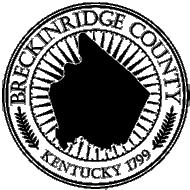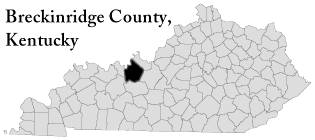 |
USGenWeb Archives Project Breckinridge County, Kentucky |
 |
 |
 |
 |
 |
USGenWeb Archives Project Breckinridge County, Kentucky |
 |
 |
 |
 |
THESE
ARCHIVES BUILT BY YOUR
CONTRIBUTIONS.
PLEASE CONTRIBUTE TODAY!
New
Easy to use Submission
Forms!
This Page Updated Monday, 11-Apr-2022 20:27:43 EDT
| BRECKINRIDGE COUNTY, KENTUCKY |
| AREA COMMUNTIES OF THE PAST AND PRESENT |
| CLOVERPORT |
Cloverport, formerly called Joe Ville was settled in the
year
1803, by a Mr. Joe Huston. The
original settlement was
just east of the mouth of Clover Creek.
This little town,
in its early days, was one of the busy spots on the Ohio River.
It was one
of the major shipping points to reach the only feasible market
for their produce. New
Orleans lay some 1000 miles south,
at the mouth of
the Mississippi River. There
were no roads through the
mountains through which one might take his produce back to the
eastern seaboard,
nor any means of transportation if there had been.
The only
market for the farmers of Breckinridge County was New Orleans,
and this meant
travel on the river. Cloverport,
because of its location,
became an important shipping point.
In 1821 the state
legislature established
one of the earliest roads in our state.
It ran from Bowling
Green to Cloverport by way of Honikers Ferry, Caneyville, Short
Creek, Falls of
Rough, where it struck Breckinridge County.
It ran from the
Falls to Rockvale, to Morton Town (now the cross roads about two
miles south
of McQuady) to Tick Ridge, which it followed through Ball Town
and on into Cloverport. The
survey was done throughout
Breckinridge
County for the sum of $50.00. It
had a 30 foot right of
way, “Said road was viewed out, aided by the compass and
chain, for the benefit of
salt and commerce for the interior.”
Tobacco was put up in hogsheads and hauled there along
with the
other crops; such as, corn, hemp, some beef and pork were
butchered, salted down in barrels and shipped as well.
Immediately after Abraham Gesner discovered how to make
coal oil
by refining coal, a vein of cannel coal was discovered nine miles
south of Cloverport, at Victoria.
It was named after Queen
Victoria of England. An
English Syndicate bought the mines
and surrounding
land. They built a
railroad track from there to Cloverport
over which to haul the coal to where it could be refined. The
products of this
coal were used in many places in the world.
A highly
luminous paraffin was made from it in Louisville and used in
candles, which gave a superior
light.
This business boomed from 1854 until Mr. Drake discovered
oil at
Titusville, Pennsylvania. Then
kerosene, refined from this
crude oil, soon put Cloverport’s cannel coal oil business on
the blink.
Near by Tar Springs, however, brought a steady flow of new
money
and faces to the little town. The
hotel in Cloverport
worked
in conjunction with Tar Springs to accommodate the visitors and
tourists. People
came from all over to see the natural
wonder and to drink its
miracle waters.
Not long after the Civil War the old hotel gave way to a
new and
magnificent three-story brick hotel.
There were also
twenty-five
cabins which furnished accommodations for four people each.
The twelve springs which are very close together give
forth as
many different kinds of water.
A Mr. Holiday owned the new hotel and in 1903 put out this
brochure.
Visit the Magic Waters of Wonder Tar Springs
“A majestic cliff forms a background to the
springs, and
towers above the entire surroundings.
It is over 100 feet
high and from its
base flows the water of the mineral springs, eleven in number.
The white sulfur and the tar water is noted far and wide
as a
cure for stomach trouble,
skin disease, suppressed menstruation, gout, rheumatism, and
chronic catarrh.
The hotel has steam heat and water works.
Rooms are fully
furnished. Bring
only towels and linens.
An analysis of a quart of water by Professor E. S. Wayn of
Cincinnatti is as follows:
Magnesium carbonate
1.46
Calcium carbonate
4.41
Sodium sulphate
.65
Magnesium chloride
1.25
Sodium sulphate
.03
Magnesium sulphate
44.27
Finious sulphate
.19
Aluminum sulphate
.03
Silicates of Potassium
4.32
Sodium magnesium
4.32
Carbonic acid
1.41
Oxygen
.06
Nitrogen
.55
Mineral tar in large quantities.
The railroad came into Cloverport in 1887 which put it
very much
on the map. A Mr.
R. B. Pierce took the contract to build
the
grade and lay the track for this section of the road.
The railroad shops had been in Henderson but burned down. The
railroad officials contracted to bring the shops to Cloverport if
the
town would donate $20,000, which they soon raised.
These
railroad shops were built in 1892.
The first master
mechanic was Mr. F. J. Ferry.
This railroad shop
employed from 150-200 men from 1892
until 1929, June 1st.
At this time the shops
were moved to a new location, and
the loss of this business added greatly to the depression that
was soon to follow. The
road, up until 1929, had been the
“Louisville, Henderson and
St. Louis,” but was taken over at this time by the
L&N.
A suit was brought against the railroad by the town for
breach of
contract and received $10,000 plus the 10 acres of ground that is
still city
property. A ball
park is there now.
The Cloverport Brick Yard was established three years
after the
coming of the railroad in 1895. It
soon got into financial
trouble and
a Mr. Murray from Massachusetts took it over and started making
roofing tile. It is
still in operation and employs about
100 people. At
present
it is the only business of any sequence with the exception of the
bank, school, blacksmith shop, and several stores.
In 1910 the town rented the Railroad shop ground to the
Polk
Canning Factory. They
hired only women. At
that time
women were frowned upon who did that kind of work, and it became
hard to get labor so they hired several Negro women.
This
caused hard feelings
among the employees and a walk out was staged.
It resulted
in the Polk Canning Co. pulling up stakes and leaving town.
Another canning factory known as the Breckinridge County
Canning
Co. came to Cloverport in 1938, but like the other one lasted
only two
years.
On March 13, 1901 at eleven o’clock, with a
strong west wind
blowing up the river, a fire broke out just where the parallel to
the lower wharf
now stands. There
was no fire fighting machinery in the
town except a bucket brigade, which proved to be of little worth.
A call was made to
Owensboro for help but none was available.
Another plea was
sent to Evansville. They
sent a fire engine as quickly as
possible by railroad. The
tracks were cleared, but when it
reached the scene Cloverport lay in ashes from the railroad to
the river all the way across town.
This was a hard blow,
but the spirit that brought Bill Hardin and the other pioneers to
our county had been handed down to them and soon a new town stood
where the old one had gone up in flames.
Cloverport has produced more than its share of great men. The
Allens, Crittendens, Murrays and Hustons will be mentioned in a
later chapter.
The Cloverport post office was established Oct. 16, 1828. The
initial postmaster was Mr. George La Hust.
He served his
community well in this capacity until the Civil War, 1862. He
was succeeded by: John
C. La Hust, 1862-84; Fredrick
Dehaven, 1884-85;
Lela Henly, 1893-97; Jonas Wilson, 1897-1901; John H. Rowland,
1901-09; Robert L. Oelze, 1909-13; Marion Weatherholt, 1913-22;
Robert L. Oelze, 1922-25;
Eva B. Jolly, 1926-34; Ressie H. Miller, 1934-52; Louise Carter,
1952-53; Alma Hawkins, 1953-62. Douglas
J. Wiles is now the
postmaster and is
in charge of a new building that the residents of the town may
well be proud of. It
was dedicated at 2:00 Dec. 5, 1965.